Desert Dueler
Nils Leufven's Mind-Altering Street Supra
671 whp @ 1.9 Bar
Text by Turbo magazine
Nils Leufven's seductive Supra should be familiar to regular Turbo readers. The Toyota was the sterling half of Team Turbo's silver-and-black attack at the BFGoodrich G-Force Challenge (December 2001), which was supposed to use street cars to test out BFG's new KD G-Force tire. The silver Supra battled against a fully sorted SCCA RX-7 and a tube-frame Bug road racer, nabbing third place in the field of 10 and missing runner-up honors by 0.3 points. To put the Supra's accomplishment in perspective, the top two arrived on trailers with slicks mounted to them, while Leufven drove his Supra from its home in Las Vegas to Willow Springs Raceway in Southern California. Leufven knows his Supras. His Web site, www.t04r.com, focuses exclusively on the power potential of the 2JZ-GTE and member cars must make at least 700 hp to be featured on the site. There's a grip of cool pics and video on the site; definitely a dream garage for those of us yearning to own a Supra.
Supras are a hot commodity in high-performance circles and have been for the last two years or so. Somewhere in the timeline, the cosmic tumblers have aligned and the price of used examples is low enough that savvy enthusiasts can afford to buy the cars and be willing to pour on the power with hard-hitting mods. On a trial blazed by drag racers Vinny Ten and Craig Paisley, the latter running deep in the 8s on stock internals, street Supras are generating absolutely mind-boggling numbers on dynos from Coast to Coast. You can use bolt-ons and get very near and even surpass 400 hp at the wheels on the stock turbos. As amazing as it sounds, 400 at the wheels will wear off and feel slow. When this happens, what do you do? For Supra owners, this is the big crossroads of performance. Do you upgrade with a twin-turbo set-up or convert to a single-turbo boosting strategy?
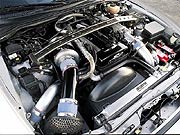
We put the Q&A on Leufven, asking him what the advantages and disadvantages of a single-turbo set-up are?
"Seems to me that a single turbo is more of an 'on and off' proposition, as there's not much of a transition in power, at least not a smooth transition. This I would consider a disadvantage, especially on the slick streets of Las Vegas. It never rains here, so dust and oil builds up on the streets and it's very hard to maintain traction. I can easily spin my tires through fourth gear (100mph+). I've experienced twin-turbo systems that can out-spool me and some that don't; the more turbo you have, single or twin, the more lag you get."
Why did you elect to go with the T04R?
"At the time, I only knew of a handful of guys running the HKS T04R turbine and after looking over T04R dyno sheets and talking to several T04R owners I realized that this turbo was what I wanted. Choosing a turbo is fairly easy, as long as you know what you want out of it. For me, a T51R was too big and a TS04 was too small, in the middle there was the T04R. It provides fairly decent spool-up with big top-end power. I've always been a fan of HKS, pretty expensive products, but hands down the best in quality."
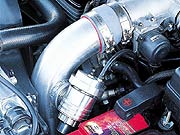
Describe the driving experience with 671 whp at the end of the throttle cable.
"Amazingly enough, with practice you get used to it and since I drive my car every day, I get a lot of practice. Very violent acceleration in any gear at any speed, most performance cars can accelerate from 0-60 fairly quickly...I spin my tires to 100 mph and then I get kicked back in my seat to about 160 mph or more. The car sits very low and sometimes it's hard to go up steep driveways. The clutch doesn't slip like normal ones do. It's OK to drive around town, but in stop-and-go traffic, it can be a bit tough, since it only allows minimal slip as you drive off in first gear. For the most part, I only drive around running 1 bar of boost, but occasionally, if I feel spiffy, I'll crank it up. The best thing is to drive by some old dude in a Viper or Corvette and shift right as I pass them--very funny. The blow-off valve is so loud, I literally scare guys out of their seats--not to mention it instigates them to come and play with me."
Has anyone messed with you on the street? How did that go?
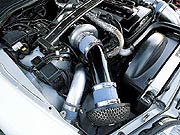
"The real fun is with motorcycles, especially Hayabusas and R1s-- the brutes of the road. Even 600cc bikes are fun to race. All motorcycles I've raced are good sports and are truly amazed that a 'brick' can keep up with them, always a 'thumbs up' after a race with a bike. I have to admit that I don't race that much on the streets--but I guarantee you that if I run in to anyone on the freeway...it's on.
"I want people to know everything in my car works like it should and I drive my car everyday... Hell, I drive it to L.A. about twice a month. My A/C, cruise, seatbelts, traction control, stereo, etc. Everything works like it's from the factory. When I first got into building my car, I wanted to create what Toyota would build if it wanted a concept car styled technically like the Supra. No crazy colors, no crazy wings, but at the same time, it's crazy when you look at its road performance and durability. It's kind of hard to explain, but to me, my car is the perfect balance between chaos and structure. Painstaking time has been devoted to picking out and waiting for the 'right' parts and no money was spared. It's the performance of the car that's so beautiful...not the body kit. I would also like to give my thanks to Alex, Jeff, Rex, Jason and Ivan at SP Engineering, Dave Mashour at PMimporting.com, my partner John Pfiel at t04r.com, Ken Henderson and, last but not least, my beautiful wife Toni Leufven."
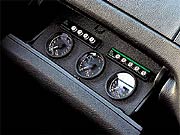
With all this focus on the induction system, many will ask about internals. You know: rods, pistons, balancing and blueprinting. The absence of thought on these subjects is no oversight, because only when approaching 700 whp are such upgrades worth considering. Even at 700, the combination of parts one uses and, most importantly, the quality of tuning may still make internal upgrades unnecessary. Leufven's Supra is a case in point. The 2JZ-GTE runs a potent combination of HKS hardware in conjunction with its T04R on all stock internals. The T04R sports a hearty .96 A/R ratio and is perched atop a trick HKS manifold. The turbo relies on an HKS GT wastegate and EVC-Pro boost controller, the company's most sophisticated unit, to regulate pressure from the mild 1 bar setting to the more aggressive 1.75 or 1.9 bar extra credit settings. Other HKS hardware includes a Racing blow-off valve, GT-spec FMIC, 1.6mm metal head gasket and a Power Flow filtration system. Leufven added to his reliability quotient by upgrading to a Fluidyne radiator and running a GReddy oil block adapter kit, which allows the use of temperature and pressure probes.
The valvetrain has been lightly modified to enhance the effectiveness of the turbo. The valves and chambers are stock, but the bumpsticks have been swapped in favor of JUN 264 units. The cams are fine-tuned with AEM cam gears and the head is kept in place with upgraded ARP fasteners.
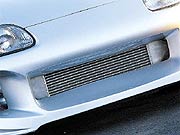
Along with power application, the suspension system plays a big role in the overall success and driving pleasure of high-power street cars. To this end, Leufven has covered all the bases. He's running Tein HA 16-position adjustable coil-overs in conjunction with Tein pillow ball mounts for added g-force resistance. Leufven's Supra has more braces than craggy-toothed teeny-bopper, as a TRD strut tower brace under the hood is joined by a Cusco carbon fiber strtut tower brace in the rear and a Do Luck floor brace just behind the bucket seats. These are joined by TRD front and rear sway bars to provide outstanding lateral stability. Upgraded brakes ensure that the suspension can be pushed to the edge and Leufven runs Brembo binders at the nose of his Supra. The Brembos feature 332x32mm cross-drilled and slotted discs with a corrosive-fighting cadmium plating. The rear set-up has been upgraded with cross-drilled rotors and Friction-Tech pads. Big power requires a matching contact patch. Leufven's Supra is shod with BFGoodrich G-Force KDs 295/35ZR-18s in the rear and 245/40ZR-18s up front. The BFG's are wrapped around Kinesis K-58 wheels that have been custom powder-coated to Nils' specs. This combination proved its worth in the heat of battle at the G-Force Challenge where the street-driven Toyota registered a 1.009g on the skidpad in "as it arrived from Las Vegas" condition. 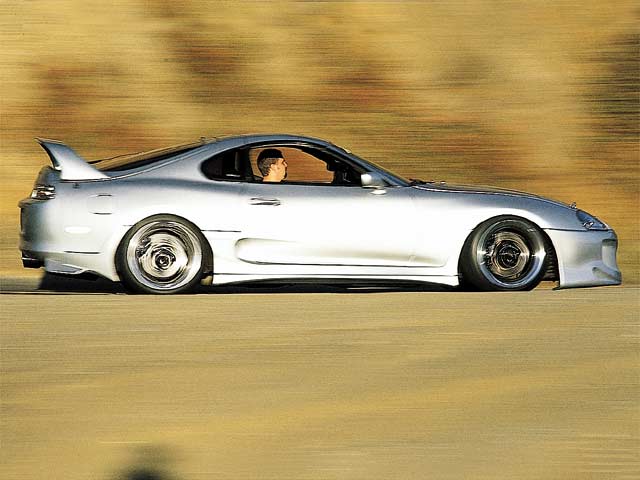
With an imaginary concept car as inspiration, a stock body would not suffice. Leufven powered up the Supra's silhouette with some wicked body armor from Bomex. A styling giant in Japan, Bomex has been in the States for a number of years scoring style points for the savvy import owner. Leufven runs a Bomex Big-Mouth front bumper cover to fashionably frame his front-mount intercooler. Aggressive rocker side skirts are joined by angular skirt panels just aft of the rear fenders to enhance the car's profile.
Back in the day, it was believed 500 to 550 whp was all the stock Supra engine could take. Perhaps 500 was all tuners were willing to pump into a car that sold for $45,000 to $50,000. Perhaps tuning electronics have evolved since then. It's certain that tuners have pushed the envelope. The past is the past, and today 670 whp on stock internals is attainable with very little compromise to reliability, which further confirms the Supra is the ultimate power production platform.
|